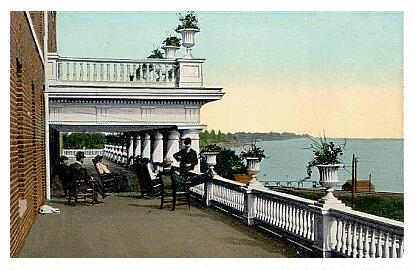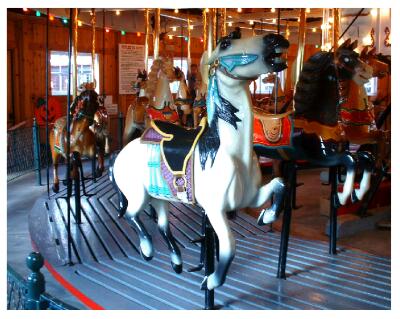
ONTARIO

Burlington
NO PART OF THE FOLLOWING
ARTICLE AND PHOTOGRAPHS
MAY BE REPRODUCED WITHOUT
PERMISSION FROM THE AUTHOR ©
(Also known as "Knapman Beach",
"Canal Amusement Park" and "Hamilton Beach")
This park was formed on a sand bar in what is today, Hamilton Harbour. It was originally owned by George Hamilton whose father Robert was one of the original settlers in the area. George subdivided his farm into lots which became the beach's first settlement. The area became a lake port for the village of Hamilton and many goods came through the area bringing more settlers along with them.
|
Burlington Beach From the Air  |
| This shows the extent of the beach area and the shape of the sand bar. |
The district prospered further with the start of The Welland Canal in the 1820s, which would connect Lakes Ontario and Erie by bypassing The Niagara River and Falls. This prompted more piers to be built in the area. By 1833, there were four hotels, three general stores, and two drinking establishments in the area. Many summer homes were constructed and the area became a haven for picnickers, fishermen and boaters.
By the 1800s, roller skating had been established, one venue was called The "Ocean House Roller Rink". This may have been in a hotel of the same name.
|
Ocean House Hotel Circa 19-0s  |
In 1891, The Royal Hamilton Yacht Club opened south of the canal. It would unfortunately burn in 1915.
|
Royal Hamilton Yacht Club Circa 19-0s  |
|
Brant Hotel Circa 19-0s or 1910s  |
| Hotel patrons relax on the verandah. The beach area is in the background. |
As the region grew, it was not lost upon H. Knapman who saw an opportunity for a recreation area. He formed The Canada Amusement Company and opened the park in 1903 with boat & bath houses, swings & slides, snack bars, and a funhouse called The "Crazy House". It apparently was known as Knapman Beach. The area did well for about a decade, so he added a ferris wheel (1912), a carousel(*) and some children's rides.
 |
At the end of The Great War in 1918, local resident Joseph Allan acquired the park. He owned a restaurant next to the amusement area, above which he lived. Allan expanded the operation with an open-air dance floor which also served as a roller skating rink. Later, The Pier Ballroom would be built on this location and big bands of the 1930s and 40s would play. Presumably when Allan took over, the "Knapman Beach" name may have been changed.
|
A Picnic Grove Circa 1910s  |
| Picnickers enjoy a nice day at Burlington Beach. |
Eventually another carousel came here from some park in London Ontario which may possibly have been Springbank Amusement Park. This ride was built around 1916 and had three rows with a chariot & spinning tub. The date certainly fits Springbank, as the amusement park started there in 1914 and it had two carousels early on. (The second may have incorporated horses from the first.) Since Springbank's rides were put up for sale in 1942, and assuming that this is the same ride, it likely came to Burlington around that time.
The carousel remained until the park's closure, after which it went into storage for a few years. It was bought in 1982 by The Carousel Society of the Niagara Frontier and may be seen today working at The Herschell Carrousel Factory Museum in North Tonawanda, New York. (See at the end of this article for further carousel discussion.)
Nothing else is known about the war years of this park, but in the 1950s there was a small roller coaster (Shiff ? Herschell ?), boat ride (Herschell ?), carousel (Herschell), pony ride, ferris wheel (Eli ?), and many snack bars.
|
The Midway Circa 1960s ?  |
This shows the pony track and boat ride. At Upper Right is the roller coaster station. Note at Upper Left the old speed limit sign in miles per hour. |
Other rides came to include a 1910 #12 Eli ferris wheel, a refurbished 1912 Sellner "Tilt-A-Whirl", 1928 Eyerly "Octopus" a 1970s-vintage "Scrambler" (Eli ?), an Eyerly "Roll-O-Plane", and a number of kiddie rides which included the german carousel that Patty Conklin of CNE fame first started out on the road with. (Note that the "Tilt" date must be wrong because the first one was not manufactured until 1923. Perhaps it was supposed to be "1932".)
One other ride was a "Lil Rocket" made by John Czabo from Lakeland Pool, which was a small park nearby. (See Below.) This is also from where The "Tilt-A-Whirl" was bought. It's unclear if some of the other rides were installed in their years of manufactures, or if they were all bought used.
A funhouse was there which was built from collected materials by E.G.& J. Knapp Amusement Company, the last operators of the amusement area. By then, the park had 19 rides, of which all but five were for children. The park ceased operations in 1978 when its lease expired; most items were auctioned in 1979. However, a wooden "Wild Mouse" was not sold and was destroyed in a bad storm by high winds. It's not clear whether this occurred before or after the auction.
Burlington Beach, now known officially as Hamilton Beach since amalgamation into the city of Hamilton in 1959, celebrated its 185th year in existence as an established settled area in 2009.
* Note that Frank Ryan, who was the Assistant General Foreman for the final four years the park operated, says that Burlington had a 2-abreast carousel which had been brought to the park around 1908 by Mr. Allan. He feels that this is the same ride about which Rose Jankowiak at the Herschell Museum is talking. Given that Mr. Allan did not take over the park until 1918, and the token evidence as seen earlier, it was likely Mr. Knapman who brought in the ride. Another source gives 1914 as the date the ride arrived, so that would mean it was a used ride at the time.On the other hand, since the park opened in 1903, the 1914 date might be wrong, and thus Knapman may have installed it as a new ride in 1908. Of course, there is always the possibility that Allan installed it as a concession ride while Knapman still ran the beach amusement area.
Rose comments: "Several of our volunteers rode the carousel at Burlington Beach and clearly remember it because of its unusual mixture of horses. Now here is the possible crossover with the 1908 carousel: The two inner rows of the museum carousel are older horses that were converted from rockers to jumpers. They formerly rode on a two-row steam-operated carousel. We are not sure just how old they are, but they are early Herschell-Spillman style: stiff legged, smiling, simple carvings, stand-up manes along the neck, and they have real horse hair tails."
"They were brought to Allan Herschell when the owner wanted a bigger carousel but didn't want to pay for inner row horses when he already had 24 of them. Hence, their conversion. Their presence on the carousel makes it a very unique machine."
Frank does say that the carousel sold after Burlington's demise was a 3-row. He helped dismantle it. This may mean that the Springbank carousel was made partially from an older carousel that was at Burlington Beach and that Burlington re-acquired it in its new form after Springbank Amusement Park closed. On the other hand, the carousel at the end of the park's run may have been a more modern Herschell unit and thus the Springbank unit went elsewhere until The Herschell Museum acquired it.
New information has come from Ken Jones of Niagara Falls, Ontario. He says: "The carousel at Burlington Beach was built by Alan Herschell in 1916, as shown at the Herschell Museum. It is original from the plant. I visited the museum in October 2005 and got a few shots of the ride and horses. Of all the horses, there is only one that is not original, and that is the lead horse."
"Apparently the person from whom they bought the ride, worked at the park until it closed, and bought the ride. He did not want to part with the lead horse. So, they took measurements, etc. and carved a new one. Other than that, the animals are original."
UPDATE!
Mark Middleton of Hamiliton, Ontario says:
"I visited the museum today (2011 05\15);
in 2009 they were able to retrieve the lead
horse. The carousel is now complete to original."

|
Carousel Lead Horse As Carved for the Museum 2005 |
Ken continues: "One unique thing about this ride is the chariot. Most carousels had two chariots, one on each side. This model had a chariot and one "love tub", as it was nicknamed. It was basically a tea-cup design, which you would sit in and spin it - and of course, be pushed against your honey (which was frowned upon in those days)."
|
The Love Tub 2005 |
 |
It appears to this author that the original Springbank and Burlington carousels were different units. One or both units may well have been modified over their life spans, but during the 1910s and later, the same carousel could not have been operating at two different parks.
Another possibility is that Springbank Park bought its first carousel used from Burlington Beach and then only two years later, incorporated that one's horses into the modified one being discussed here. Later, the modified ride went to Burlington.
I suggest that the original Burlington unit was replaced with the Springbank one in the 1940s. Further, this is the one which was sold when Burlington Park closed and is the one at the Herschell factory today. Given that two carousels are mentioned regarding Springbank's early years, it's possible that the Herschell company made Springbank's second one incorporating the first one's horses, as described earlier. In the 1940s, this hybrid unit came to Burlington. It's also possible that Burlington sold its 1908 unit to Springbank which then modified it, and that version eventually came back to Burlington. Research continues. See the Springbank Amusement Park article for the carousel story from its point of view.
|
Thanks to Rose Jankowiak of Cheektowaga, New York and Frank Ryan
of Hamilton, Ontario for information on Burlington Beach. A thankyou goes to author Dorothy Turcotte of Grimsby, Ontario for further information on this park. Thanks to Janet Forjanfor of Hamilton, Ontario for additional facts. Thanks to Ken Jones of Niagara Falls, Ontario for the carousel photos. See his site: -Niagara's Lost Amusement Parks Appreciation goes to Larry Laevens of Cambridge, Ontario for the carousel token scan. |
Return to the
Closed Canadian Parks Index
